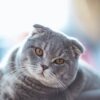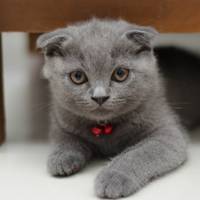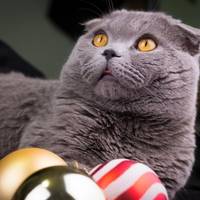Spotlight – The Rottweiler
Hello everyone and welcome to this spotlight edition of Val Talk’s Pets. In these spotlight episodes I like to highlight a breed of dog or cat and talk about their […]

 play_arrow
play_arrowspotlight – The Scottish Fold Cat Val Cairney

Hi everyone and welcome to this spotlight episode of Val Talk’s Pets. So, I have chosen a cat breed for this spotlight episode and I have a reason for choosing this one. Many years ago, I was involved in some specific events with my local SPCA. I was at the shelter and I went into the cat room just to look at the cats. There was this little cat, beautiful white and sort of caramel colour, super cute, but it looked like her ears had been bent over. I asked at the counter about the cat’s ears and they just said that this is the way she looked when she was surrendered. Well, was I ever stupid, because this was a little Scottish Fold. This breed is really interesting, and if I had been on the ball, I would have adopted that little cat right away because I would have had a Scottish Fold that I got at the shelter! So, note to everyone, always check the shelters.
I think Scottish Folds are quite cute and they have been likened to looking like an owl in a cat suit. Let’s take a look at the history of the Scottish Fold.

Well I just love this history of origin as set out by Wikipedia. “The original Scottish Fold was a white barn cat named Susie, who was found at a farm near Coupar Angus in Perthshire Scotland in 1961. Susie’s ears had an unusual fold in their middle, making her resemble an owl. When Susie had kittens, two of them were born with folded ears and one was acquired by William Ross, a neighbouring farmer and cat-fancier. Ross registered the breed with the Governing Council of the Cat Fancy or GCCF in the United Kingdom in 1966 and started to breed Scottish Fold kittens with the help of a geneticist named Pat Turner. The breeding programme produced 76 kittens in the first three years – 42 with folded ears and 34 with straight ears. The conclusion from this was that the ear mutation is due to a simple dominant gene. Susie’s only reproducing offspring was a female Fold named Snooks who was also white; a second kitten was neutered shortly after birth. Three months after Snooks’ birth, Susie was killed by a car. All Scottish Fold cats share a common ancestry to Susie” The Scottish Fold was granted championship status by The Cat Fanciers Association (CFA) in 1978.
So let’s look at some interesting facts as set out by The Cat Fanciers’ Association. Interestingly, some Scottish Folds do not have folded ears and these cats are referred to as Straight Eared. However, if the kitten has the incomplete dominant gene, the ears will fold due to the spontaneous mutation. It will not be until the kitten is about 3 or 4 weeks however, before the ear will begin to fold, or it may not. The kitten will need to be about 11 or 12 weeks before it can really be determined if it is a show Scottish Fold. Presently, only folded ear cats of Scottish lineage are permitted in the show ring. But, this is not to say that the straight eared Folds are not valuable. They are, as the gene they may be carrying is invaluable to the breeding programme.
Let’s look a little deeper into this gene mutation. According to The Spruce Pets, “the fold is an incomplete autosomal dominant gene that affect the development of cartilage and bone throughout the cat’s body.” Gender is not a factor. “A cat that has two copies of the gene is said to be homozygous. Cats that have two copies of the gene that produces folded ears can have severe health problems including crippling arthritis at a young age. Those cats are not bred due to ethical concerns.” Or so it is said right? Well this would mean that you need to make sure if you are interested in a Scottish Fold you should make sure you go through a reputable breeder that can show the genetic testing results. “Cats that have one copy of the gene are said to be heterozygous. These should display the folded ear characteristic. They may develop arthritis but usually will do so at an older age. These cats with folded ears are bred to cats that do not display the folded ear trait to ensure none of the litter receive two copies of the gene. So, as The Spruce Pets continues to explain, “It is best not to breed a heterozygous Scottish Fold with a Scottish Fold that had straight ears, but instead to outbreed with a British Shorthair. The concern is that the Scottish folds that have straight ears may still have the gene but not express it.” And this is very interesting, “Many veterinarians oppose breeding Scottish folds as all cats with the gene have osteochondrodysplasia and may experience pain and suffering due to it. Debates are active in countries where breeding continues. Now, although William Ross registered his fold with the Governing Council of the cat Fancy in the U.K. in 1966, in 1971 this was withdrawn due to ethical concerns about the health of the cats. Breeding has continued in the U.S and elsewhere and they are accepted in the American Cat Fanciers Association, Cat Fanciers Association, and The International Cat Association.

Scottish Folds are hearty cats due to their barn cat ancestry. They are not skittish cats and do well in a home with children and dogs. Generally, according to The Spruce Pets, Scottish Folds have a short coat, but a long coated variant does exist. They can come in a large variety of colours and patterns. Their eyes can be green, blue-green and gold. They are not very meow-y cats and they are very intelligent so interactive toys are a good idea. They do like to play but they are not the type of cat that goes 100 miles an hour around the house. They like their attention and they do shed like most cats and do have a denser coat, so grooming is obviously part of their care.
In terms of their health issues, aside from the obvious issue of osteochondrodysplasia, they can also be prone to Polycystic kidney disease which is an inherited condition and cardiomyopathy.
Now, we know that the fold in the ears is a result of a mutation and there is controversy here, so just to add a bit more for you to think about, there has been some fooling around with the genetics to create not only a one folded ear cat, but a double fold and a triple fold. These are defined by beautyfold.ca as, a “Double-fold is a tighter fold than the single-folded ear” and “Triple-fold, [is] with the ear-bending forward so much that the ears lie almost flat to the head. The triple-folded ear is considered ideal in cats used in show.” Oh boy. Nothing can never be left alone. So, this bit of information is quite interesting as related by beautyfold.ca. Because it is very important for the health of the breed to not breed one fold to another there are strict guidelines. However, that was not always the case. “Once the folds were brought to America, little was known about the natural mutation which results in the folded ear. In the early 1970’s Dr. Oliphant Jackson an English geneticist, released a report stating that the breed carried a bone problem. The decision was made, the report stated, that changes and the vital use of outcrosses were needed to restore the original health of Folds. About this time, x-rays of Folds started showing bone lesions. According to Jackson’s report, there had been no previous mention of associated skeletal deformity before the 70’s. Scientists and breeders agreed that these were caused by excessive in-breeding early in the history of the Folds rather than by the Fdgene itself.” “It is through careful breeding over the last 15-20 years that we are now seeing folded cats showing no adverse effects caused by the early inbreeding.”

So all in all, Scottish Fold cats can be a great choice for a multi pet home and a home with kids. But, they also are great in a single human home. They love their humans and although quite laid back, they are not the best at being left alone for long extended amounts of time. They are very interactive and they have a very funny propensity to stand on their hind legs and sleep on their back, which means they sometimes snore. The issue with regards to the degenerative joint disease that affects cartilage and bone development is a concern. If you are looking at a Scottish Fold for adoption you should check that their tail and leg joints are not stiff, or that there is any movement problem with their legs or feet.
So, I guess back when I saw the little Scottish Fold in the shelter it could have been the degenerative bone and cartilage issue for the reason it was surrendered. Who knows. I do hope she got a very good home though. A Scottish Fold is a super cute and interesting cat to have. Their strong and laid back nature plus their non-skittish nature and being able to get along with other cats and cat friendly dogs, really makes them appealing. But, there is an issue to be aware of, so as always, do your homework, expect the utmost integrity on the breeder’s part to be following the strict guidelines and expect proof of such, because as I say, knowing is caring!
Support The Show
For the price of a coffee, or more if you are feeling generous, you can help keep this podcast going & growing. Please visit my ko-fi page to make a donation. Thanks for all your support!
Please remember to follow or subscribe to ensure that you never miss an episode.
Please don’t forget to Rate and Review each episode that you find helpful/educational. By doing so you will help others find Val Talks Pets.
Email me at: val@valtalkspets.com with topics you think would be of interest or with any questions you may have.
Also, visit and be a part of my website at valtalkspets.com and help it grow!
Thanks for listening!
Tagged as: Scottish Fold, cat breed, scottish cats, cat breeds.
Hi everyone, and welcome to Val Talk’s Pets, the forum for pet parents and enthusiasts alike. So, I have been working in the pet industry now for almost 10 years and, on a daily basis, I handle a lot of issues and questions arising from pet parents. I am not a veterinarian but I do have certifications in Canine, Feline, Small Animal, Fish and Herptile and Avian Health and Nutrition from the University of California, Davis Extension, the Vet College.
Val Cairney March 4, 2022
Hello everyone and welcome to this spotlight edition of Val Talk’s Pets. In these spotlight episodes I like to highlight a breed of dog or cat and talk about their […]
Val Cairney August 29, 2025
Val Cairney August 15, 2025
For the price of a coffee, or more if you are feeling generous, you can help keep this podcast going & growing. Please visit my ko-fi page to make a donation. Thanks!
all rights reserved - Val Talks Pets - 2024